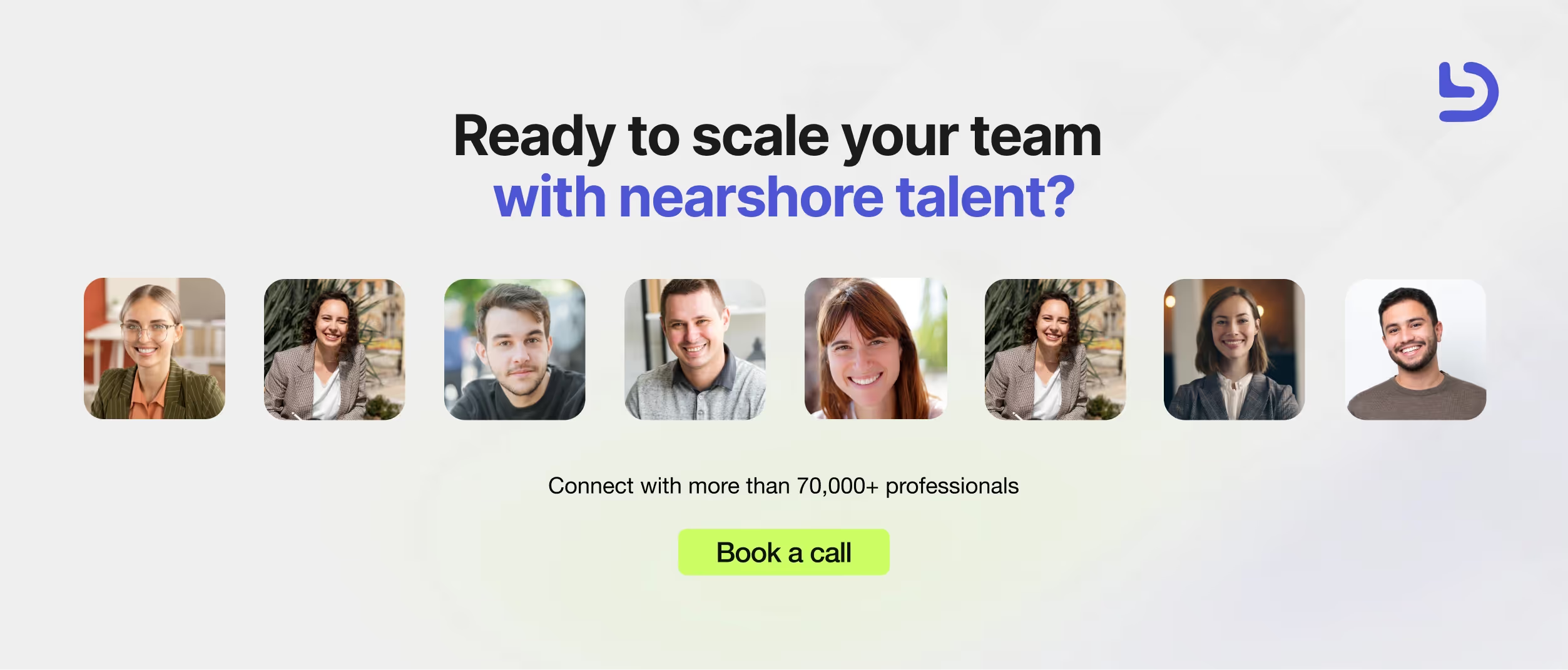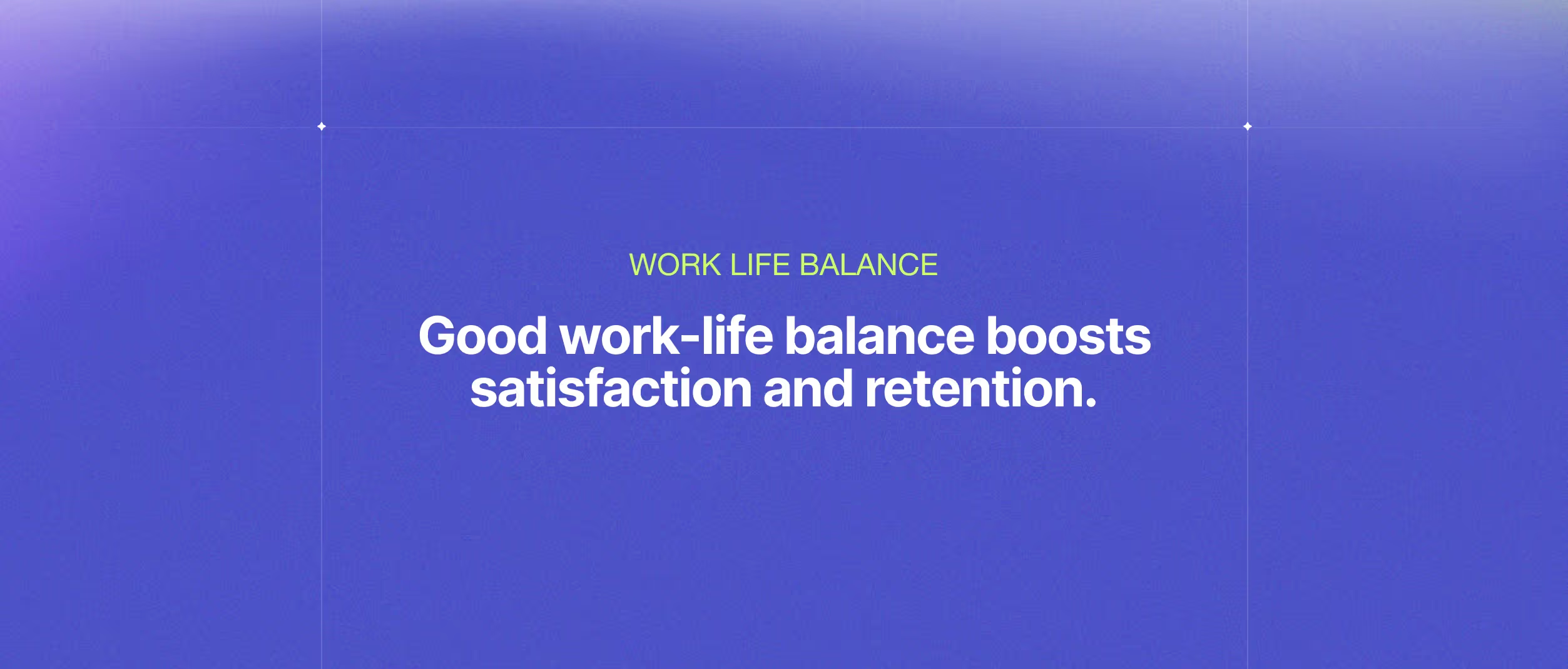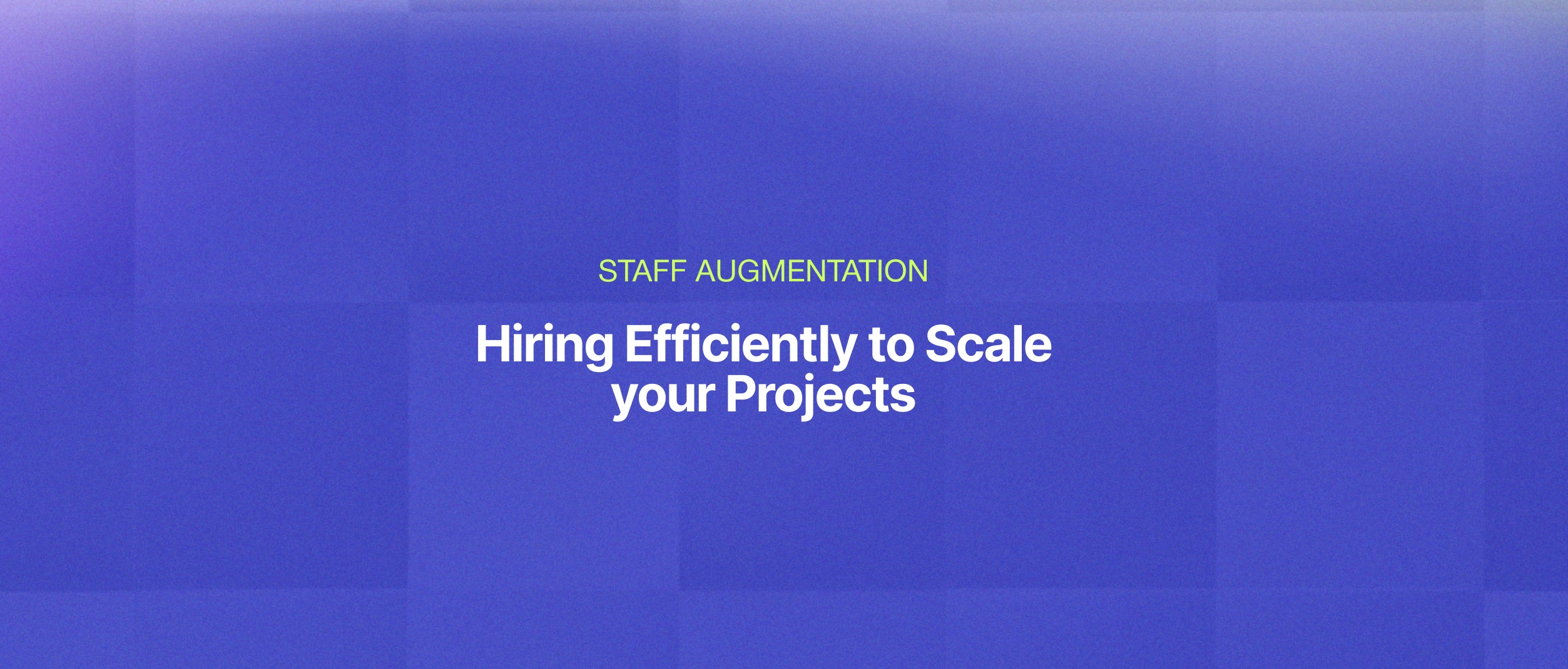A staff augmentation model is a flexible workforce solution that allows companies to quickly scale their teams by adding external professionals to work alongside full-time employees. Instead of replacing your internal staff, staff augmentation works by complementing your in-house talent with specialized experts who can fill skill gaps and accelerate delivery. This approach—also called resource augmentation—is particularly effective for tech and software development projects that require specific expertise on a temporary or project-based basis.
Unlike traditional outsourcing, staff augmentation gives you full control over the workflow and project management while reducing the long-term costs of hiring and training. It helps organizations stay agile and maintain a flexible workforce, adapting easily to changing priorities or deadlines. Whether your goal is to boost productivity, expand your technical capacity, or scale your development team without increasing permanent headcount, understanding what staff augmentation is can be a key competitive advantage in today’s fast-moving business environment.
Resource augmentation (also known as IT staffing) is an outsourcing strategy that is used to acquire staff based on specific criteria to help assist and meet project objectives.
This technique allows businesses to evaluate their current staff capabilities and determine where skill-gaps may be present.
Once you determine the need to outsource a project, it’s time to decide the strategy on how to add professional members to your team.
Hiring Efficiently to Scale your Projects
Recruiting new talent is always a challenging task that comes with an unpredictable outcome.
No matter how efficient your recruiting team is, a company that provides IT Staff Augmentation services will always be an efficient strategy if you need the help of finding external resources and scaling your team as soon as possible.
The most well-known approach of external service methods is outsourcing, which is a practice of complete delegation of some components of the development process.
The variety of the outsourced services is significant and you may find anything that software development implies: from testing to coding to design.
But at the same time, the main disadvantage of outsourcing is its risks due to the client-company's low control level.
Here’s where staffing augmentation comes into play. The outsourced development company connects companies with developers, and incorporates the outsourced developers to the core in-house team.
This also helps you to scale-up and down efficiently in comparison to the traditional hiring process.
What is IT Staff Augmentation?
Staff Augmentation is an outsourcing strategy used to staff a project and respond to the business objectives. The technique consists of evaluating the existing staff and then determining which additional skills are required.
Staff Augmentation is a flexible outsourcing strategy that enables you to hire tech talent globally and manage your augmented team directly.
You are the one to choose from the candidates that fit your requirements and to cut or extend your augmented team whenever you need to.
IT Staff Augmentation vendors help you add skilled technical resources to your in-house development team on either a short or long-term basis.
These resources are employed directly by the vendor, thus the cost and liability of making new full-time hires are eliminated. Remote developers hired through a Staff Augmentation company are dedicated to one project at a time.
“Why Staff Augmentation?” you may ask.
“Why not hire a few more people for the project on a permanent basis?”. This is simple: you won’t need additional staff permanently.
You will need the highly-qualified and narrowly-aimed professionals for the work to be done, or improve upon.
.avif)
Advantages of Staff Augmentation
COST-EFFECTIVENESS
What is the reason to pay for the additional workers annually, if you need them only during a short period?
With the Staff Augmentation you pay only for the required work when you need it, and for the expected skills at the right time.
Paying no full-time wages annually companies save huge financial resources each of the short-time and long-time perspective.
FLEXIBILITY
Staying flexible in the business is sometimes the most important factor to a business’ success. The adaptivity is a great feature that helps reach top lines in your business area.
CONTROL
With the augmented staff it’s elementary to maintain full control over all the aspects of the project developed.
The project manager simply monitors who is allocated to the important work, who is on the minor tasks, and who is working on the critical issues. Controlling the process is controlling the quality of the end product.
LOWER RISK
OOne of the aspects of software development with high-risk concentration is full outsourcing. Giving all the responsibility for the development to the outsourcer, you decrease the control and status monitoring almost to the very end of the development.
Augmenting your staff you basically do the same thing as the outsourcing, but you keep it in-house: you hold the situation under control, and you react to any issue in the blink of an eye.
COUNTERACTING ATTRITION
The latest studies have demonstrated that up to 50% of IT specialists are ready to look for another employment opportunity as the economy improves.
As the attrition in the IT-sphere is inevitable during the economic upturn, the augmented staff will fill your need for software engineers.
Staff Augmentation evolved from a necessity to address short-term resource constraints, budgetary pressures, and headcount limits. This practice served the organization best when skills were required for immediate and short-term engagements.
IT and operation managers utilized external resources to fill internal resource gaps while avoiding hiring people into fixed positions. When the project was complete, the external resource would no longer be on the manager’s budget.
This model worked well until Staff Augmentation started to be viewed as a long-term solution. Projects were completed, however, the external resources contract was not terminated.
As the external resource gained knowledge of internal systems, processes, and people, he or she became valuable, if not indispensable.
When one project ended, he or she was redeployed to the next project and continued as a contractor with the company for any number of years.
The continued growth in staff augmentation (now at tens of billions of dollars, on a global basis) is due to several market factors, including the profusion of professionals preferring to work independently, steadily declining rates, and a seemingly never-ending margin.
Types of Staff Augmentation
Staff augmentation can be categorized into different types based on the level of expertise required and the nature of the tasks. These categories help businesses identify the right talent to meet their specific project needs. The main types of staff augmentation are:
.avif)
Commodity-Based Augmentation
Commodity-based augmentation involves hiring temporary workers for tasks that require minimal specialized skills or expertise. These roles often include basic administrative tasks, data entry, or other routine operations. This type of augmentation is typically used for short-term needs where the primary focus is on filling a position quickly rather than on the level of expertise.
Skill-Based Augmentation
Skill-based augmentation focuses on bringing in professionals with specific skills that are not readily available within the existing team. These roles often include tasks that require specialized knowledge, such as graphic design, IT support, or basic programming. Companies use this type of augmentation when they need specific skills for a particular project but do not require a long-term commitment or highly advanced expertise.
Highly-Skilled Augmentation
Highly-skilled augmentation is used when a project requires top-tier experts with specialized knowledge and experience in a particular field. These professionals are often brought in for complex tasks such as software development, advanced engineering, or strategic consulting. This type of augmentation is essential for projects that demand high-level expertise and precision, where the outcome is critical to the business's success.
When to choose for an Staff Augmentation Service?
1. You already have engineers working on your product in the local office, but you want to extend your team to have programmers develop another part of the product. You need to hire a team of tech professionals, but it’s impossible due to the shortage of your local talent market. You realize that local recruitment will take too long and together with the risks and strong demand on the market this option is not viable.
2. You are developing a tech product together with a team of programmers and you need to add new engineers to your team. As the stack of professionals that you intend to hire is rare in your country, you’re looking to extend your search to other locations.
3. You cooperate with a project outsourcing company to develop your product, but this model doesn’t fit you for several reasons. First, you want to communicate with your team daily, and second, you wish to be well-acquainted with your remote programmers to make sure they feel like part of your local team. Both of these are crucial for remote team integration with the local team and the motivation to follow a common goal with you and the in-house team.
4. You have a knowledge-gap on your team and need a specific set of skills for a specific project.
Common Types of Staff Augmentation Services
Staff augmentation services can be tailored to meet various business needs, depending on the scope, location, and structure of the project. Here are some of the most common types:
On-Site Staff Augmentation
On-site staff augmentation involves bringing external professionals into your physical workspace to collaborate directly with your in-house team. This approach is ideal for projects requiring close coordination, hands-on involvement, or when the nature of the work demands a physical presence, such as in manufacturing, R&D, or certain IT roles. It allows for real-time communication and immediate feedback, which can enhance productivity and alignment.
Remote Staff Augmentation
Remote staff augmentation leverages external talent who work from different locations, often across different time zones. This type of augmentation is perfect for projects where physical presence is not necessary, such as software development, customer support, or digital marketing. Remote staff augmentation offers flexibility, access to a global talent pool, and can be cost-effective, allowing businesses to tap into specialized skills regardless of geographic constraints.
Project-Based Staff Augmentation
Project-based staff augmentation is designed for specific, short-term projects with clearly defined objectives and timelines. Companies hire external professionals to work on a particular project from start to finish, providing the exact expertise needed without a long-term commitment. This approach is beneficial when tackling specialized projects like a software launch, marketing campaign, or infrastructure upgrade, where the required skills may not be available internally.
Team-Based Staff Augmentation
Team-based staff augmentation involves bringing in a complete external team, including project managers, developers, designers, and other specialists, to work on a specific project or to fill a functional gap within the company. This model is useful when a project requires a cohesive team that can operate independently yet remain aligned with the company’s goals. It’s ideal for large-scale projects, such as developing a new product line or implementing a major system overhaul, where an integrated team approach ensures consistency and efficiency.
How to Succeed with Team Augmentation?
- Choose a vendor that will provide your remote developers with separate team follow up, all the necessary tools, and in a time-zone near yours.
- Make sure remote developers feel the effect of being with your local team. Good and fluent communication is key to the success of every business. You have to develop the process early in the development lifecycle to enable open communication. Team collaboration and project management tools encourage idea-sharing.
- Ask the vendor whether they have professionals who will help you collaborate with your team more efficiently. For example, HR/Client Managers that work alongside your developers and help eradicate all potential misunderstandings throughout your cooperation.
- Identify the skill-gap in your Company: Every business process requires an in-depth analysis. This can be instrumental in providing you the insights regarding the talent gaps present within the organization. Whether it is about evaluating the current project needs or planning for the upcoming projects, going for a talent audit is essential. Once you fill the holes, determine the requirement of the candidate. Here’s where Staff Augmentation helps you to bridge the gap.
The Bottom Line
Staff Augmentation allows a company to sustain its competitive advantage.
As this model provides companies with a huge list of benefits like less operational cost, less legal responsibilities and paperwork, it provides more flexibility.
Augmentation addresses various issues giving the company a steady and consistent capacity of the workforce. It saves time, money, and effort involved in the hiring process.
Every company looking for growth should seriously consider this hiring model.
With the right employees hired by the Staff Augmentation model, you will be able to gain a new perspective on how things can work. The efficiency and disciple that the experts bring will encourage the in-house staff as well to improve their performance.
Want to embrace the IT Staff Augmentation model for your new projects?
Staff Augmentation allows a company to sustain its competitive advantage.
As this model provides companies with a huge list of benefits like less operational cost, less legal responsibilities and paperwork, it provides more flexibility.
Augmentation addresses various issues giving the company a steady and consistent capacity of the workforce. It saves time, money, and effort involved in the hiring process.
Every company looking for growth should seriously consider this hiring model.
With the right employees hired by the Staff Augmentation model, you will be able to gain a new perspective on how things can work. The efficiency and discipline that the experts bring will encourage the in-house staff as well to improve their performance.
Want to embrace the IT Staff Augmentation model for your new projects?
At Devlane we can offer you all of our knowledge and expertise on everything related to Dedicated Teams & Staff Augmentation.
Our experience has ranged from working with entrepreneurs looking to kick off their business, to leading international companies that offer apps with millions of daily active users.
From mobile and web applications to Blockchain development, we can realize your project surpassing the standard quality that the market has to offer.
Get to know everything our company has to offer to your organization over at our website.

Other Blog Posts

Work-Life Balance: The Solution to High Turnover of Software Engineers?

Why hire Latin American Developers for your business?








